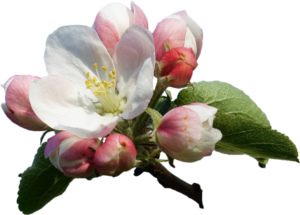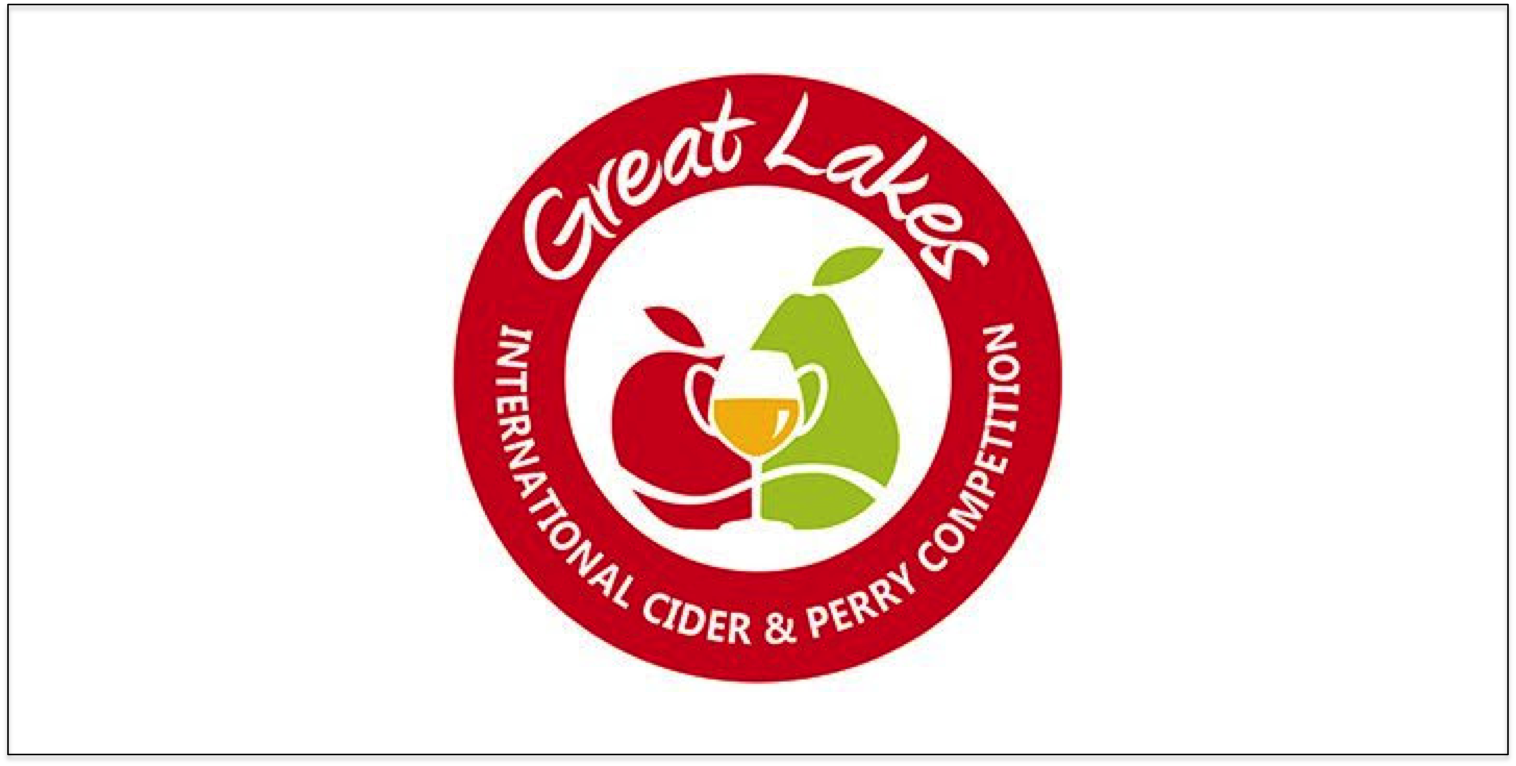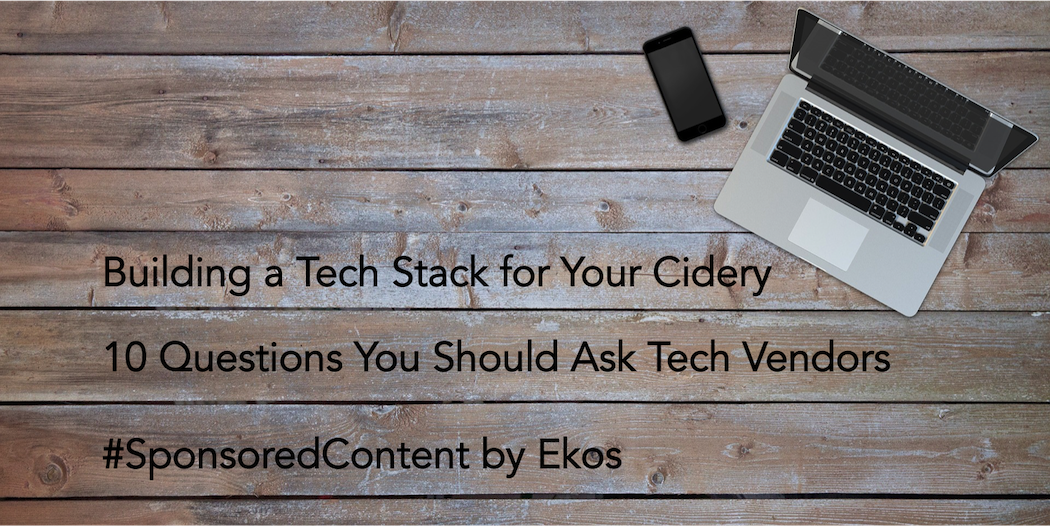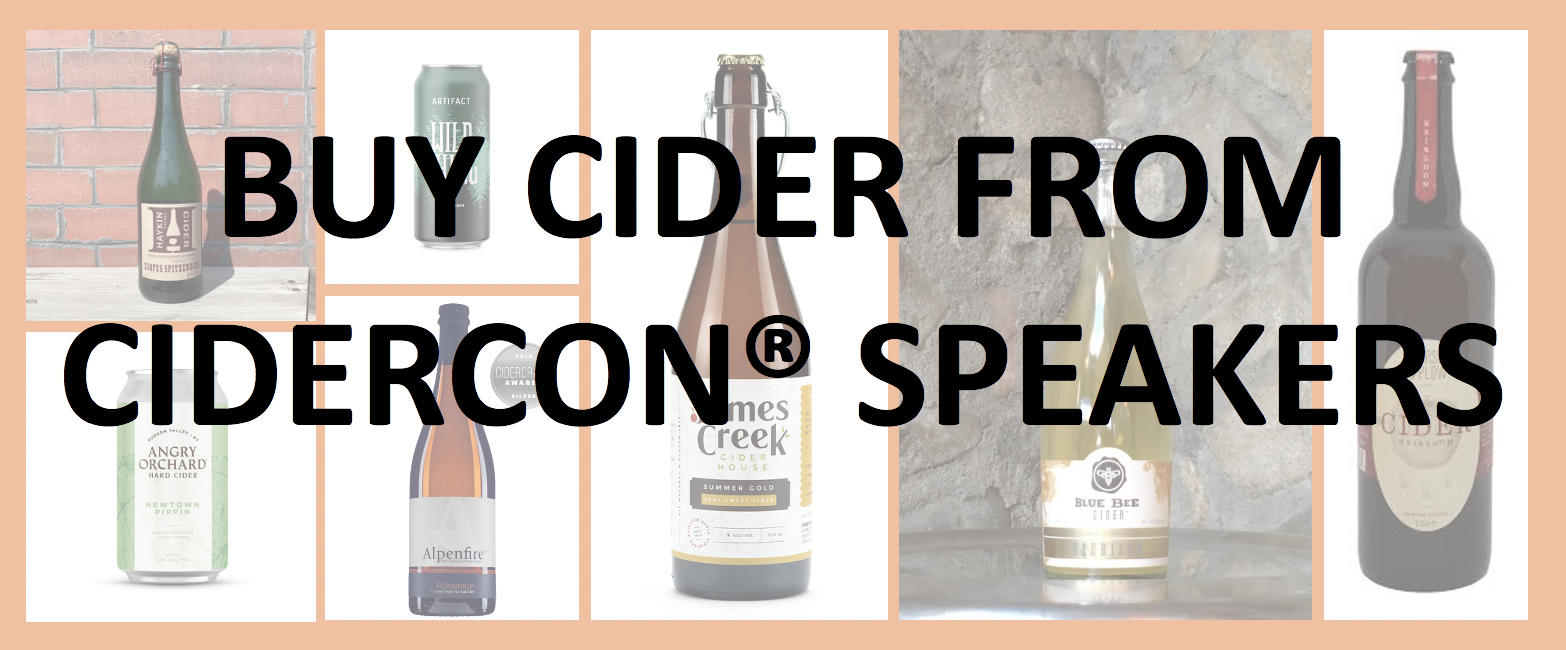Uncategorized
Urge Congress to Replenish the Restaurant Revitalization Fund
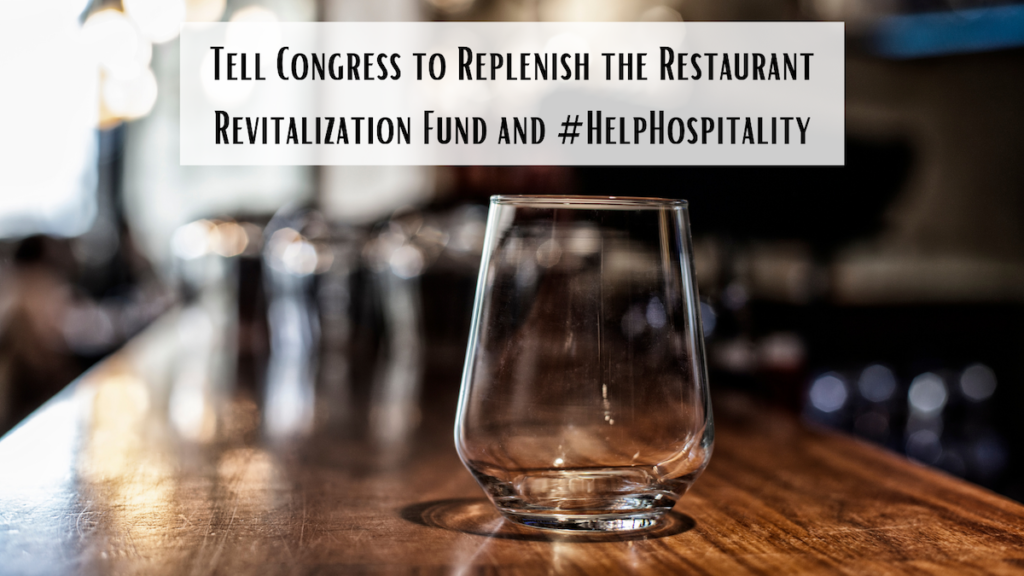
While we appreciate Congressional support for the Restaurant Revitalization Fund, it is clear that cideries and others in the hospitality industry are still in need of additional support. Submitted claims far outstripped what was provided in March 2021 by approximately $50 billion. Refilling the RRF is an important step in the hospitality industry’s recovery from the COVID-19 crisis.
New bipartisan legislation provides much-needed economic relief to the hospitality industry, including restaurants, bars, cideries, and other craft alcohol businesses with tasting rooms. With fewer Americans dining out, traveling, or gathering for events, these businesses have seen dramatic declines in revenue and struggled to reopen. Through this legislation, eligible entities may receive grants to help cover payroll, mortgage or rent payments, utilities, operational expenses, and other eligible expenses.
We’re asking Congress to provide relief to hospitality businesses still struggling to survive, and we need your help. After Congress established the Restaurant Revitalization Fund (RRF) last spring, the initial round of funding left 177,000 eligible businesses without a penny of relief.
According to research by the National Restaurant Association, the RRF saved more than 900,000 jobs at restaurants that received grants. Their estimates indicate that fully funding the RRF will save more than 1.6 million restaurant jobs.
Congress is weeks away from considering a spending bill for all government operations. It’s critical that this package include additional support for the RRF!
Join us in urging your Members of Congress to support additional funding for the Restaurant Revitalization Fund (RRF) by passing the Continuing Emergency Support for Restaurants Act (S. 2675)!
The Crafty Cask Giveaway
This content is for members only.
If you were a member and are now seeing this message, please Renew your membership to continue.
GLINTCAP – What You Need to Know
Please read below for the latest updates on GLINTCAP 2021 from competition director Eric West including tentative scheduling for 2021 and how to submit your entries.

Based on what is currently known about the pace of the COVID-19 vaccine rollout in the US, the 15th Annual Great Lakes International Cider and Perry Competition (GLINTCAP) will be rescheduled for late July to early August. This postponement will ensure the safety of our judges, stewards, and staff, and allow the judging to be held as normally as possible.
When the rescheduled event dates are confirmed with the venue, we will make an official announcement via email and social media. Until then, we ask that potential volunteers not commit to specific travel plans.
Entry registration for the 2021 event is open from now until Friday July 2nd at https://glintcap.org/register/. Entry fees are frozen at their 2020 levels: $75 per Commercial Division entry and $22.50 per Noncommercial Division entry. There will be no Early Registration window or Late Registration window for 2021.
There is no limit to the number of entries you may register in 2021, and you may register additional entries until registration closes on Friday July 2nd, simply by submitting a new entry form. You may not, however, enter the same product into multiple style categories. Visit https://glintcap.org/rules/ for a complete list of rules and regulations.
Samples must arrive at a designated collection point no later than Friday July 16th. Collection points in the United States (Vander Mill) and Canada (Twin Pines) remain the same as in recent years. Visit https://glintcap.org/shipping/ for complete details.
Entrants who registered in 2020 can make changes to their entries at no cost by emailing me (eric@ciderguide.com) between now and Friday July 2nd. These changes include swapping out one cider/perry for another, or editing details for an existing entry such as apple/pear varieties and ABV. Search your email account for the subject “GLINTCAP 2020 Entry Confirmation” for a record of what you have previously entered.
If you already shipped your samples in 2020 and wish to send fresher samples for the July 2021 event, we are offering a $20 refund per Commercial Division entry and a $10 refund per Noncommercial Division entry to offset your costs. Please email me (eric@ciderguide.com) to confirm whether you intend to send new samples for the July 2021 event.
We are now accepting judge applications for this year’s competition. There are also volunteer opportunities available for stewards, who pour samples for judges and help organize paperwork. Please visit https://glintcap.org/volunteer/ and complete the questionnaire if interested. If you registered to volunteer in 2020, please email me (eric@ciderguide.com) to confirm whether you intend to participate in the 2021 event.
We appreciate your understanding of yet another postponement. We will reach out again when the rescheduled dates for the judging are confirmed, and will notify you of any changes that may impact the timing or format of the 2021 event.
Eric West
Competition Director
Restaurant Revitalization Fund Webinar with SBA
This content is for members only.
If you were a member and are now seeing this message, please Renew your membership to continue.
Annual Membership Meeting Recording Available!
In the meeting, we reviewed last year’s accomplishments, took a look at our new strategic plan, and talked about our future activities to support the cider industry.
You must be an Active ACA Member to view the Annual Membership Meeting. You can become a member or update your membership here.
Check out the recording of this year’s ACA Annual Membership Meeting by clicking here! You will be prompted to login prior to being able to access the link to the recording.
Building a Tech Stack for Your Cidery: 10 Questions You Should Ask Tech Vendors
#SponsoredContent by Ekos
If you’re reading this blog, you probably already know that technology is essential to any craft cider businesses. “Software gives the craft market a leg up against the larger, more entrenched beverage companies,” said Josh McKinney, Ekos CEO and co-founder. You might only have the resources to hire a small team, but technology allows you to make the most of what you have. “If it makes your team more efficient so you can spend more time with customers or on differentiating your brand in the market, then it is time and money well spent,” said McKinney.
So, you’ve determined you need to invest in a piece of software, but you’re not sure which vendor to choose. Before you start evaluating your options, make sure you know the problem you’re trying to solve and your desired outcome. For example, if you’re looking for inventory software, are you trying to get more organized? Communicate better with your team? Keep more accurate records? Sync inventory transactions with your accounting software to save time? Whatever your goal, make sure you (and any other stakeholders) nail it down and figure out what features the tech solution should have in order to meet your needs.
Want to learn what technology cideries are using for POS, ecommerce, accounting, inventory, sales and more? Download an analysis of 1,500 cideries and breweries.
5 Tips for Choosing a Software Solution
1. Make sure the vendor can solve your problem.
Now that you know what you’re trying to accomplish, it’s time to evaluate vendors on how effectively they can help. Once you’ve reviewed basic marketing materials to get an idea of what the software offers, be sure to set up a demo so you can see what the product actually looks like and how it works. But remember: no solution will be 100% perfect, so prioritize your top features and make sure the vendor checks off the most important boxes.
Depending on your specific needs, some general categories to consider include:
- Analytics, reporting, and business intelligence capabilities
- How you can access the platform (look for a cloud-based system)
- Integrations to other software you’re already using.
2. Set a budget, and make sure you know the “all-in” cost.
Using technology to solve your problems costs money, but fitting it into your budget is possible as long as you know the true cost. Most software-as-a-service (SaaS) companies will charge a subscription fee, but make sure you ask for all other associated costs. For example, does the company charge you for each additional user? Or, for an ecommerce or POS system, what are their website hosting or credit card processing fees?
Keep in mind that a cheap solution is often just that — cheap. Instead of trying to find a cut-rate option, simply decide how much you can afford to spend and add it to your list of considerations as you evaluate vendors.
3. Find out if the vendor is familiar with your industry.
Many craft beverage businesses have found out the hard way that big software companies cater to enterprise clients and are often ill-equipped to handle the needs of a craft cidery. Sure, they’ll tell you their platform can be used for anything — which really means the platform is incredibly generic with few, if any, features that are specific to cider production.
Plus, frankly, you’ll likely struggle to get hands-on support when you’re competing for attention against companies with multi-million-dollar, or even billion-dollar, annual revenues. Ask vendors if they are well-versed in working with businesses of your size and type — but you’ll probably be able to tell quickly just based on their industry knowledge (or lack thereof).
4. Investigate your options for customer support and any associated fees.
Another important factor to consider is what types of support the vendor makes available. Ideally, you would have the option of online and phone support in addition to a database of help articles. Make sure you understand the support packages and choose the one that makes sense for your team. You’ll also want to know whether you get hands-on onboarding and training (with a real person) as a new customer, and the company’s overall commitment to service. Will you have to wait a week for a response to a support ticket? If you have a problem during off-hours, is there a robust database of support articles for you to reference? What about ways to give product feedback? These should all be questions you ask.
5. Talk to your peers and ask for customer references.
This one’s a no-brainer, but if a company can’t offer references within your industry, you might want to look elsewhere. Ask the vendor to provide references that are as similar to your business as possible so you can properly compare.
Questions to Ask Potential Tech Vendors
- How will your software help us achieve our goals?
- What does an ideal relationship between us look like?
- What is your commitment to service?
- What’s your company mission?
- What is my “out”?
- What happens if/when challenges arise? How do you handle conflict?
- Knowing my needs, what is the “all in” cost to use your software?
- Is my business type and size typical for your client base?
- Is your software easy to use on a mobile device?
- How easy is it to get support? Does it cost anything?
To learn more about the tech solutions craft makers rely on, download Building a Tech Stack: An Analysis of Breweries and Cideries and get insights from 1,500 craft producers.
Download the Q4 Cider Trends Report
This content is for members only.
If you were a member and are now seeing this message, please Renew your membership to continue.
Exploring Diversity of Cider Profiles Through the Selection of New Yeast Strains
by Etienne Dorignac –Technical Manager, Fruit Fermentation
#SponsoredContent by Fermentis
Introduction
Although the global cider market has been constantly growing over the past 15 years, , the growth rate has progressively slowed down in the last 5 years. In fact, we see from the last data published (AICV) that the significant increase of consumption observed between 2005 and 2015, from 13.5 million hectoliters (MhL) to 24 MhLs, mainly driven by new regions such as North America, Australasia and Africa versus older markets such as West Europe and Latin America, progressively flattened out to reach about 26 MhLs in 2019. In addition, the distribution between regions has not been changing much in recent years… In this context, cidermakers are facing competition challenges and need to find new ways to boost their market by standing apart from each other. Among the main diversification tools they have in hands, the choice of the raw materials and the recipe; but also the selection of the yeast strain and the conditions applied to carry out the fermentation can drastically affect cider organoleptic profiles. In this way, Fermentis R&D selected 4 new yeast strains dedicated to ciders whose characterization will be presented in this article.
Evaluation of different yeast strains through different types of cidermaking
- Cider?
What could be considered as a “cider” is actually very variable depending on the countries and the substrates: 100% apples, types of apples, addition of other fruits such as pears, usage of juice, concentrates or external sugars. In addition, the number of recipes can hugely differ, what makes a standard study almost impossible.
As a consequence, the characterization was based on 4 major recipes that could embrace the main problematics faced by cidermakers around the world: types of apples used, source and quantity of sugars, completion or voluntary stop of fermentation (to eventually leave some residual sugars) and fermentation temperature.
The different recipes are detailed in Table 1.
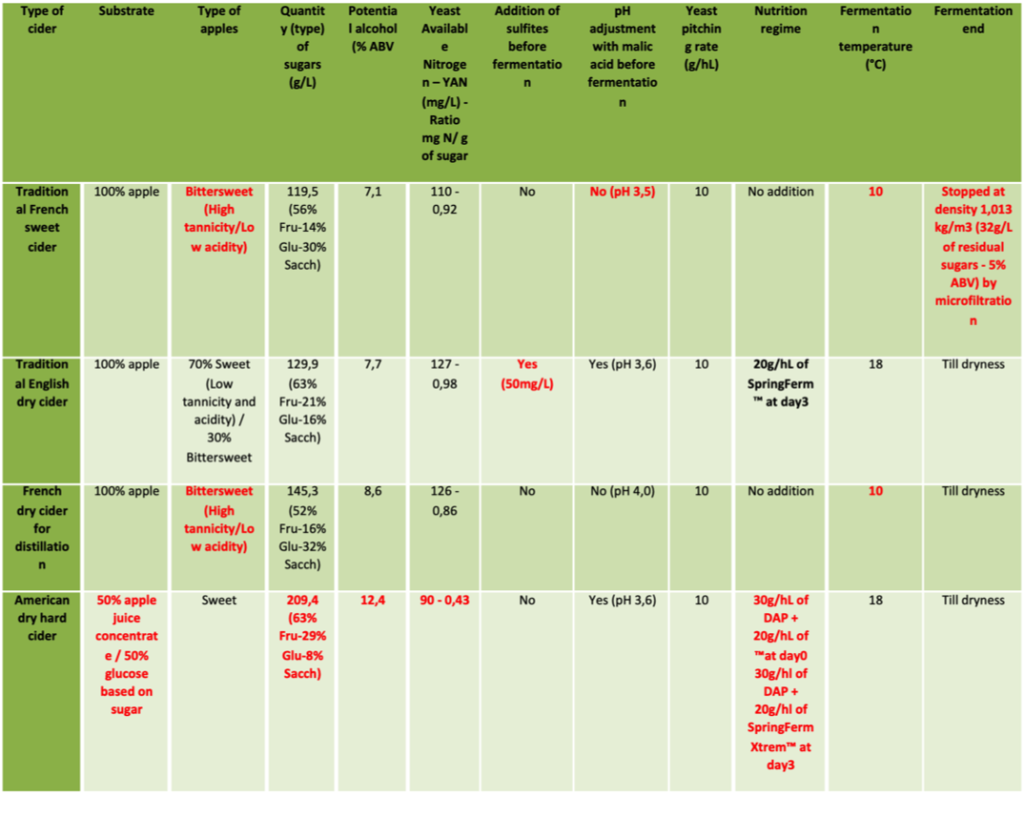
All fermentations have been carried out at the experimental cellar of the Institut Français des Productions Cidricoles (IFPC), French research institute specialized in cidermaking; in 15L glass vessels, with a standardized oxygen rate addition (1.5mg/L) and under inert atmosphere (N2).
2. Strain characterization
It is easily understandable that, from the traditional French sweet cider to the American hard dry cider, most of the fermentation conditions are becoming increasingly difficult even though nutrition and temperature were adjusted. It was then interesting to try different yeast strains through all these recipes in order to select the most diverse and interesting ones. From more than 20 strains evaluated, we’ll highlight the main results for 4 of them (SafCider™ AB-1, SafCider™ TF-6, SafCider™ AS-2 and SafCider™ AC-4) , more specifically as it relates to their robustness; and their analytical and aromatic profiles.
a. Robustness
To assess the robustness of the strains towards difficult fermentation conditions, i.e. high sugar concentration (and content in the most difficult to assimilate fermentable sugars, i.e. fructose), low pH, nutrient deficiency, low temperature… Figure 1 shows the kinetics as well as the remaining sugars at the end of the fermentation in the hard cider. The strain SafCider™ TF-6 clearly stands apart from the other strains as it was not able to finish the fermentation and typically left ~25 g/L of sugars, among which fructose was a major part. This feature was observed in most of all matrices, as TF-6 was only able to finish the fermentation till dryness in the English cider (high YAN, low tannicity, then less inhibition and more O2 availability, high temperature), highlighting the bigger needs of this particular strain and the fact that the selection can be crucial depending on the cidermaker target. A higher sensitivity to high concentration of SO2 (50 mg/L maximum) is as well to be noticed for this strain.

b. Analytical Profile
All basic analytical parameters at the end of the fermentation have been determined. Among the most interesting ones, the acidity profile is of particular interest as it reflects the metabolic behavior of the strain that could have a real impact on the organoleptic profile. Figure 2 shows the acidity profiles of strains in the English cider recipe. Most significant with SafCider™ AB-1 and maybe not as much with the other strains, we could see that some strains are able to consume the major organic acid present in apples, i.e. the malic acid, in significant amount through the malo-ethanolic pathway; and thus decreasing the total acidity and its feeling. To the contrary, some strains, such as SafCider™ AC-4, are preserving this acidity and maintain a crispy feeling (observed but not shown here). Moreover, the ability of strains to produce acetic acid during fermentation from the glycolysis pathway can also affect the aromatic profile, degrading its quality at too high concentration (vinegar flavors). For this attribute, all strains were selected for their low production with always the SafCider™ TF-6 being a “clean” strain towards deviations like SO2 and acetaldehyde production as well.

c. Aromatic Profile
In addition to higher alcohols, two major types of aromatic compounds are produced by yeast strains during fermentation and have a significant impact on the aromatic profile of all beverages: (1) the acetate esters, whose most famous and abundant one is the isoamyl acetate with its distinctive banana and candy notes and which is recognized as an overall aroma enhancer; and (2) the ethyl esters, whose most abundant ones are the linear chain ethyl esters from 4 to 10 carbons (C4-butanoate, C6-hexanoate, C8-octanoate and C10-decanoate) and which confer more discrete but more complex floral and fruity characters. Huge differences in the release of these compounds can drastically affect the flavor perceptions of beverages, the same applying for ciders. In Figure 3, all matrices have been taken to compare the aromatic behavior of the strains in different conditions.
We noticed big differences between strains; and even if aromatic compounds concentrations were of course impacted by the recipe and more specifically the amount of sugars fermented (especially for isoamyl acetate whose acetate part is directly linked to the glycolysis pathway), we could extract common trends. Except for the English cider, SafCider™ TF-6 showed always higher production of isoamyl acetate than others. This will be illustrated in terms of flavor but also aromatic intensity in the last paragraph of this article. For the English cider only, SafCider™ TF-6 was indeed able to dry the sugars and not leave any residual sugars, suggesting a strong relationship between the stress generated at the end of the fermentation and the aroma produced. SafCider™ AC-4 showed particularly high but quite stable ethyl esters production (driven by ethyl octanoate – fruity/floral), hypothesizing a reliable complexity in the flavors. SafCider™ AB-1 and particularly SafCider™ AS-2 increased their ester production along with the difficulty of the recipe with SafCider™ AB-1 being on the low values, more respecting the raw material.

*: Sole recipe in which TF-6 was able to dry the sugars. NA = Non-Available.
Focus on French Traditional Sweet Cider – Strain Baseline
Relying on the expertise of IFPC and their trained taste panel specialized on French traditional sweet ciders, professional tastings have been carried out on French cider experiments, both stopped with around ~30 g/L of residual sugars (called “Brut” ciders in French). The specificity of this tasting was to assess first the global fruitiness of the ciders with two major descriptors: (1) “Fruity/Floral” corresponding to fresh fruit (apple, pear, banana…) feeling; and (2) “Cooked fruits” related to ripe or processed fruits (like compote), aromas that are not necessarily looked for but adding complexity to the final cider. After this evaluation, it was then asked to tasters to detail fresh and cooked fruit notes to identify the aromatic drivers for each strain and to evaluate off-flavors as well, such as phenolic and sulfury aromas. Finally, a simple evaluation of the basic tastes was done: Sweet, acid, bitter and astringent.
From these tastings, SafCider™ TF-6 (especially) and SafCider™ AS-2 were scored as the highest in fresh but also cooked fruits, whereas SafCider™ AC-4 was judged less expressive and predominantly oriented towards freshness; and SafCider™ AB-1 was more discrete (data not shown).
More interesting were the detailed fresh fruits perceived by tasters as shown in Figure 4. Obviously, sensory characterization of all ciders was driven by detection of apple notes, but SafCider™ TF-6 scored high for most of the fruits, especially banana-pear and red fruits. SafCider™ AS-2 and SafCider™ AC-4 respectively exhibited more citrus and floral notes, whereas SafCider™ AB-1 was mainly centered on apple.

Both these general and detailed notes are actually quite well related with the production of aromatic compounds highlighted in the previous paragraph; with higher production of isoamyl acetate by SafCider™ TF-6, offering thus more aromatic intensity but enhanced aromatic complexity towards the other fruits as well; followed by SafCider™ AS-2 and SafCider™ AC-4, the latter producing mainly ethyl esters such as ethyl octanoate; which could explain these red fruits and specifically floral notes. SafCider™ AB-1 was the less exuberant and expressing more the raw material thanks to its quite discrete aroma production.
Together with mouthfeel attributes assessment (data not shown) confirming higher acidity feeling for SafCider™ AC-4 in line with its acidity maintenance and the sweetness feelings for SafCider™ TF-6 and SafCider™ AS-2 possibly linked to their high candy-like aromatic intensity and their higher remaining fructose level (higher sweetening power than glucose or saccharose), Fermentis suggested the map in Figure 5 to describe the impact of these 4 yeast strains and to serve as a baseline for cidermakers in their choices.

Conclusion
Yeast strains may have a huge impact on cider profiles, not only in terms of fermentation performances and analytics but for sure also from a sensory perception standpoint. As such, they can be considered as a powerful tool to diversify the cider offer in the market and cidermakers can play with them to achieve their final product target. For this purpose, Fermentis focused its research on the selection of valuable strains dedicated for ciders. SafCider™ AB-1 (Apple Balanced) will suit for all types of balanced ciders even under difficult fermentation conditions. SafCider™ AS-2 (Apple Sweet) will bring to sweet and dry ciders complex aromatic profile between fresh and cooked fruits and a rounder mouthfeel. SafCider™ AC-4 (Apple Crisp) will be applied for highly fresh and crisp sweet or dry ciders. SafCider™ TF-6 (Tutti Fruiti) will be dedicated to intensely fruity but rather sweet and round ciders!
CiderCon 2021: Sustainability Leadership Action Group
This CiderCon session will take place Thursday, February 4, Noon to 1PM PST.

This facilitated Leadership Action Group breakout session begins the process of exploring the practices and metrics that are – or could be— the call signs of a sustainable cider enterprise and industry. This interactive session kicks off with a brief orientation on sustainability and measurement with sustainability strategy and reporting expert Lisa Spicka of Maracuja Solutions. With this background as reference, participants will share sustainability successes and challenges with peers. Finally, the group will work through a series of discussions to identify how sustainability might be leveraged to elevate the performance and reputation of the cider industry and its businesses, with a focus on the metrics that might be measured to help tell the story. You won’t want to miss being a part of this Thought Leadership initiative!
Pre-Registration Requested: To enhance session outcomes, we request that participants pre-register via this Google Form by February 2nd. The Form (@ 5-10 minutes to complete) includes simple background questions. However, you won’t be turned away if you “show up” the day of the session!
Buy Cider Direct from CiderCon® 2021 Featured Speakers
While we may not have our normal tasting sessions at CiderCon® this year, you CAN purchase the ciders made by our wonderful speakers to sip on while you participate in a virtual CiderCon® from the comfort of your home. We’ve compiled this helpful guide (listed by session, cidery, and speaker) of where you can buy cider online from the cidermakers speaking at CiderCon® 2021. Make your purchases today so they will arrive in time to enjoy during the conference—or, purchase them later to enjoy during a replay of one of the 35+ recorded CiderCon 2021® sessions.
Factors to Consider When Making Sparkling Cider
- Angry Orchard – Ryan Burk (Walden, NY Pick Up Only)
Strategies for Creating a Successful Blend
- Silo Distillery – Nicole Leibon
- Eve’s Cider – Autumn Stoscheck
- Horse & Plow – Chris Condos
Quince Fermentation
- Art + Science – Dan Rinke and Kim Hamblin
- South Hill Cider – Steve Selin
- Little Pomona – James Forbes
- Pilton Cider – Martin Berkeley
Co-Fermentation in Natural Cider
- Zafa Wines – Krista Scruggs
- Wildcraft Cider Works – Sean Kelly
- Botanist & Barrel – Kether Smith
Improving the Shelf Life of Canned Cider
- 2 Towns Ciderhouse – Dave Takush
- Austin Eastciders – Brittnay Perlo
How to Build the Financial Section of Your Business Plan
- Artifact Cider – Jake Mazar
Cidernomics 102: Evaluating Sales Channel Economics
- Eden Ciders – Eleanor Leger
Consumer Expectations of Single Varietal Ciders
- Alpenfire – Philippe Bishop
- Blue Bee Cider – Courtney Mailer
Winter Orchard Care 101
- James Creek Cider House – David and Ann Marie Thornton
Cider Clubs: Growth, Opportunities, & Tools
- Haykin Family Cider – Talia Haykin


